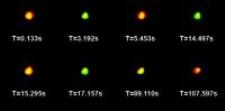A research team at the Ohio State University has discovered a nano-particle that twinkles in different colors to help label molecules in biomedical tests. The plastic nano-particles are filled with quantum dots that glow in red, yellow or green to help identify molecules under a microscope.
 OSU's Blinking Quantum Dots
OSU's Blinking Quantum Dots
The particles can be specifically monitored to glow in particular colors to help identify specific molecules. Quantum dots are semiconductor bits that measure a few nanometers. They cannot be seen by the naked eye, but when they absorb energy from the light beamed on them they start to glow. Quantum mechanical effects cause them to shine intermittently at rare moments. Multiple dots that cluster together seem to glow steadily.
The team grouped a few dots of varying colors together in a micelle. A micelle is a nano-container, shaped like a sphere used in laboratory tests. Household articles such as soap create micelles that hold oils in water. Ruan developed micelles with polymers, using different red and green combination of quantum dots within them. The micelles seemed to shine steadily. Those filled with only red dots shone red, and those with green shone green. But those filled with red and green dots shifted from red to green to yellow. The change occurs when any dot twinkles in the micelle. When a red dot goes off and the green blinks on, the micelle shines green. The reverse also holds true. The yellow is caused by human perception of light.
This research was jointly funded by the National Science Foundation, a grant from the William G. Lowrie family to the Department of Chemical and Biomolecular Engineering, and the Center for Emergent Materials at Ohio State.
Source: http://www.osu.edu/